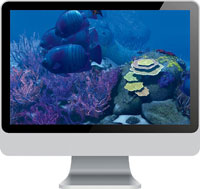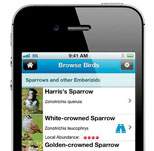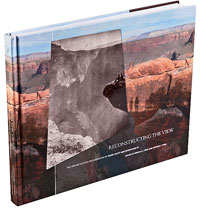sierraclub.org - sierra magazine - may/june 2013 - mixed media: crowdsourced nature
Crowdsourced Nature
by Jake Abrahamson
Crowds may save the planet. Here's a look at some projects that use citizen scientists, development hobbyists, and amateur photographers to enrich—or at least temporarily excite—our passion for the wild world.
Digital Deep
 There's something pleasantly hypnotic about a fake sardine batting its tail fin, and you'll find plenty of this and more in TheBlu, a simulated undersea environment being marketed as "the world's first social digital ocean." Actually, it's an app, with a series of aquatic habitats populated with digital fish crowdsourced from artists and software developers. There's a free version and a $20 "Pro" version to, well, dive into (25 percent of the proceeds go to ocean-focused nonprofits). You can take the plunge from your Mac or PC, but not your phone.
There's something pleasantly hypnotic about a fake sardine batting its tail fin, and you'll find plenty of this and more in TheBlu, a simulated undersea environment being marketed as "the world's first social digital ocean." Actually, it's an app, with a series of aquatic habitats populated with digital fish crowdsourced from artists and software developers. There's a free version and a $20 "Pro" version to, well, dive into (25 percent of the proceeds go to ocean-focused nonprofits). You can take the plunge from your Mac or PC, but not your phone.
Real-Life Tweets
 If you're a bird buff, download the app BIRDLOG, and what might have started as a solitary romp in the woods can suddenly support conservation research. The easy-to-use program allows you to check off bird sightings in a database, which ornithologists and citizen scientists then access to find trends in species distribution. It also doubles as a journal of your birdwatching exploits. When you return from the field, check out EBIRD, a website that builds vibrant maps and graphs from BirdLog data from around the world.
If you're a bird buff, download the app BIRDLOG, and what might have started as a solitary romp in the woods can suddenly support conservation research. The easy-to-use program allows you to check off bird sightings in a database, which ornithologists and citizen scientists then access to find trends in species distribution. It also doubles as a journal of your birdwatching exploits. When you return from the field, check out EBIRD, a website that builds vibrant maps and graphs from BirdLog data from around the world.
Two By Two
Project Noah is like BirdLog for the rest of the animal kingdom. And this app has a "missions" option that allows users to create their own local databases. With projects ranging from "snakes of the world" to "shrimp of Northern California" to "animal architecture," there's something for everyone. Another great feature: If you spot a striking creature on your hike but aren't sure what it is, you can upload a photo and ask others to identify it.

The Old, Renewed
Sometimes the crowd you source from is long dead. For Reconstructing the View (University of California Press, 2012), Byron Wolfe and Mark Klett rephotographed places in the Grand Canyon that appear in classic images and, collage style, combined the old and new. They turned to souvenir postcards and Flickr and to famous photographers like Ansel Adams and Edward Weston. The resulting pictures are vexing, dreamy, beautiful, and provocative lessons in how the texture of nature photographs can shape the way we imagine wild places.